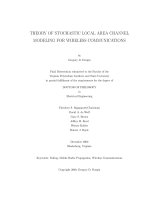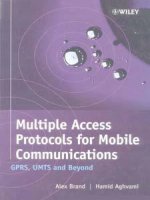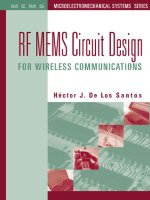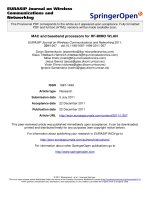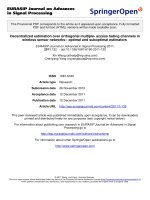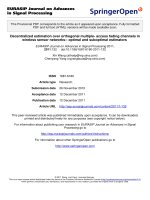Multiple Access Techniques for Wireless Communications ppsx
Bạn đang xem bản rút gọn của tài liệu. Xem và tải ngay bản đầy đủ của tài liệu tại đây (682.28 KB, 60 trang )
Multiple Access Techniques for Wireless
Communications
2005/07/06
Weng Chien-Erh
Wireless Access
Tech. Lab.
CCU
Wireless Access Tech. Lab.
Table of Contents(1)
Introduction
FDMA
TDMA
CDMA
SS (Spread Spectrum)
FHSS
DSSS
Hybrid
Wireless Access
Tech. Lab.
CCU
Wireless Access Tech. Lab.
Packet Radio
Pure ALOHA
Slotted ALOHA
CSMA
Reservation Protocol
Reservation-ALOHA
PRMA
NC-PRMA
Table of Contents(2)
Wireless Access
Tech. Lab.
CCU
Wireless Access Tech. Lab.
Introduction (1)
Multiple Access:
Enable many mobile users to share simultaneously radio spectrum.
Provide for the sharing of channel capacity between a number of
transmitters at different locations.
Aim to share a channel between two or more signals in such way that each
signal can be received without interference from another.
Wireless Access
Tech. Lab.
CCU
Wireless Access Tech. Lab.
Introduction (2)
Wireless Access
Tech. Lab.
CCU
Wireless Access Tech. Lab.
Introduction (3)
In conventional telephone systems, it is possible to talk and listen simultaneously,
called duplexing.
Duplexing
Allow the possibility of talking and listening simultaneously.
Frequency Division Duplex (FDD)
Provides two distinct bands of frequencies for every user
Time Division Duplex (TDD)
Multiple users share a signal channel by taking turns in time
domain
Each duplexing channel has both a forward time slot and a
reverse time slot to facilitate bidirectional communication.
Wireless Access
Tech. Lab.
CCU
Wireless Access Tech. Lab.
Introduction (4)
Wireless Access
Tech. Lab.
CCU
Wireless Access Tech. Lab.
Each transmitter is allocated a channel with a particular bandwidth.
All transmitters are able to transmit simultaneously.
Frequency Division Multiple Access
(FDMA) (1)
Wireless Access
Tech. Lab.
CCU
Wireless Access Tech. Lab.
Frequency Division Multiple Access
(FDMA) (2)
Allocation of separate channels to FDMA signals
Wireless Access
Tech. Lab.
CCU
Wireless Access Tech. Lab.
Time-frequency characteristic of FDMA
Frequency Division Multiple Access
(FDMA) (3)
Wireless Access
Tech. Lab.
CCU
Wireless Access Tech. Lab.
Features of FDMA
If an FDMA channel is not in sue, then it sits idle and can’t be used by
other users.
Transmit simultaneously and continuously.
FDMA is usually implemented in narrowband systems.
Its symbol time is large as compared to the average delay
spread.
Frequency Division Multiple Access
(FDMA) (4)
Wireless Access
Tech. Lab.
CCU
Wireless Access Tech. Lab.
Features of FDMA (Cont.)
For continuous transmission, fewer bits are needed for overhead
purposes (such as synchronization and framing bits) as compared to
TDMA.
FDMA uses duplexers since both TX and RX operate at the same time.
Frequency Division Multiple Access
(FDMA) (5)
Wireless Access
Tech. Lab.
CCU
Wireless Access Tech. Lab.
Transmitter share a common channel.
Only one transmitter is allowed to transmit at a time.
Synchronous TDMA: access to the channel is restricted to regular.
Asynchronous TDMA: a station may transmit at any time that the channel
is free.
Time Division Multiple Access (TDMA) (1)
Wireless Access
Tech. Lab.
CCU
Wireless Access Tech. Lab.
Allocation of time slot in TDMA
Time Division Multiple Access (TDMA) (2)
Wireless Access
Tech. Lab.
CCU
Wireless Access Tech. Lab.
Time-frequency characteristic of synchronous TDMA
Time Division Multiple Access (TDMA) (3)
Wireless Access
Tech. Lab.
CCU
Wireless Access Tech. Lab.
Time Division Multiple Access (TDMA) (4)
Features of TDMA (Cont.)
TDMA systems divide the radio spectrum into time slots.
Each user occupies a cyclically repeating time slot.
Transmit data in a buffer-and-burst method, thus the transmission for
any user is not continuous.
TDMA has TDD and FDD modes.
Wireless Access
Tech. Lab.
CCU
Wireless Access Tech. Lab.
TDMA Frame Structure
Time Division Multiple Access (TDMA) (5)
Wireless Access
Tech. Lab.
CCU
Wireless Access Tech. Lab.
TDMA Frame Structure (Cont.)
In TDMA, the preamble contains the address and synchronization
information that both the base station and the mobiles use to identify
each other.
Different TDMA standards have different TDMA frame structures.
Time Division Multiple Access (TDMA) (6)
Wireless Access
Tech. Lab.
CCU
Wireless Access Tech. Lab.
Features of TDMA (Cont.)
Share a single carrier frequency with several users.
Data transmission is not continuous, but occurs in bursts.
No duplexers is required since users employ different time slots for
transmission and reception.
TDMA can allocate different numbers of time slots per frame to
different users, allowing bandwidth be supplied on demand to different
users.
Time Division Multiple Access (TDMA) (7)
Wireless Access
Tech. Lab.
CCU
Wireless Access Tech. Lab.
Combined used of synchronous TDMA and FDMA
Time Division Multiple Access (TDMA) (8)
Wireless Access
Tech. Lab.
CCU
Wireless Access Tech. Lab.
Asynchronous TDMA: Carrier-Sense Multiple Access (CSMA)
Allows a transmitter to access the channel at any time that is not being
used by another transmitter.
Time Division Multiple Access (TDMA) (8)
Wireless Access
Tech. Lab.
CCU
Wireless Access Tech. Lab.
Transmitter may transmit at the same time, in the same channel.
Each signal is modified by spreading it over a large bandwidth.
This spreading occurs by combining the transmitter signal with a
spreading sequence.
Code Division Multiple Access (CDMA) (1)
Wireless Access
Tech. Lab.
CCU
Wireless Access Tech. Lab.
Code Division Multiple Access (CDMA) (2)
Wireless Access
Tech. Lab.
CCU
Wireless Access Tech. Lab.
example
Code Division Multiple Access (CDMA) (3)
Wireless Access
Tech. Lab.
CCU
Wireless Access Tech. Lab.
Features of CDMA
Many users of a CDMA system share the same frequency.
The symbol (chip) duration is very short and usually much less than the
channel delay spread.
The near-far problem occurs at a CDMA RX if an undesired user has a
high detected power as compared to the desired user.
Code Division Multiple Access (CDMA) (4)
